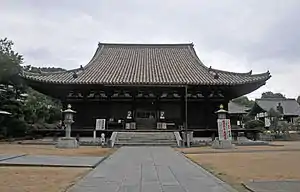Taisan-ji (Matsuyama)
Taisan-ji (太山寺) is a Shingon temple in Matsuyama, Ehime Prefecture, Japan. It is Temple 52 on the Shikoku 88 temple pilgrimage, and Temple 3 on the Thirteen Buddhist Sites of Iyo.[1] The Hondō is a National Treasure.

History
Taisan-ji is said to have been founded by a wealthy merchant from Kyushu in the sixth century, after he had been saved from a shipwreck by Jūichimen Kannon. The temple enjoyed imperial patronage from the time of Emperor Shōmu.[2]
Buildings
Treasures
- Wooden statue of Jūichimen Kannon (木造十一面観音立像) (Heian period) (Important Cultural Property)[9][10][11]
- Wooden statue of Jūichimen Kannon (hibutsu) (木造十一面観音立像) (Heian period) (Important Cultural Property)[12][13]
See also
| Wikimedia Commons has media related to Taisanji (Matsuyama). |
References
- "伊予十三佛霊場会 霊場寺院のご案内". iyo13.web.fc2.com. Retrieved 24 September 2019.
- Miyata, Taisen (2006). The 88 Temples of Shikoku Island, Japan. Koyasan Buddhist Temple, Los Angeles. p. 104.
- "Taisanji Hondō". Matsuyama City. Archived from the original on 27 September 2011. Retrieved 20 April 2011.
- "Database of Registered National Cultural Properties". Agency for Cultural Affairs. Retrieved 20 April 2011.
- "Taisanji Hondō" (PDF). Ehime Prefecture. Retrieved 20 April 2011.
- "Taisanji Niōmon". Matsuyama City. Archived from the original on 27 September 2011. Retrieved 20 April 2011.
- "Database of Registered National Cultural Properties". Agency for Cultural Affairs. Retrieved 20 April 2011.
- "Taisanji Niōmon" (PDF). Ehime Prefecture. Retrieved 20 April 2011.
- "Taisanji Jūichimen Kannon". Matsuyama City. Archived from the original on 27 September 2011. Retrieved 20 April 2011.
- "Database of Registered National Cultural Properties". Agency for Cultural Affairs. Retrieved 20 April 2011.
- "Taisanji Jūichimen Kannon" (PDF). Ehime Prefecture. Retrieved 20 April 2011.
- "Taisanji Jūichimen Kannon". Matsuyama City. Archived from the original on 27 September 2011. Retrieved 20 April 2011.
- "Database of Registered National Cultural Properties". Agency for Cultural Affairs. Retrieved 20 April 2011.
This article is issued from Wikipedia. The text is licensed under Creative Commons - Attribution - Sharealike. Additional terms may apply for the media files.